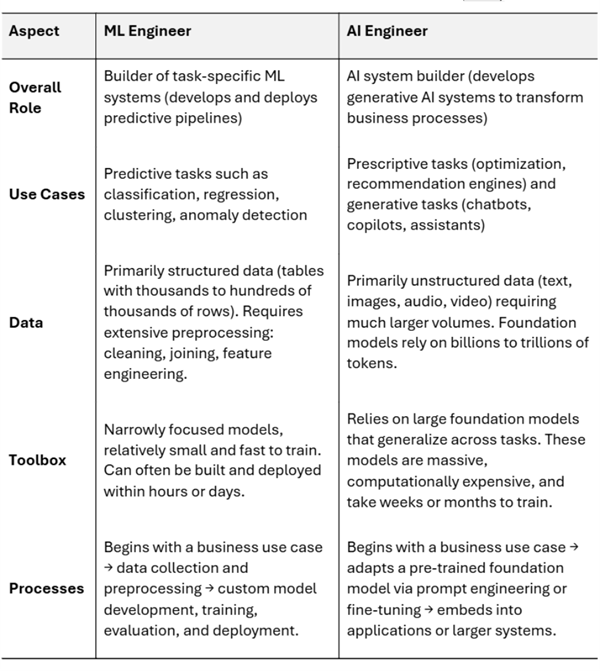Same World, Different Jobs
Artificial intelligence is everywhere these days. It recommends what we should watch next, powers the chatbots we talk to online, catches suspicious transactions at the bank, and even lends a hand in hospitals. But behind these technologies are people with very different responsibilities. Two roles often get mentioned in the same breath — machine learning (ML) engineers and AI engineers.
At first glance, they might look like the same job with different titles. Both work with algorithms, both care about data, and both build things that fall under the AI umbrella. But if you look closer, their worlds are not quite the same.
From ML to AI: Narrow vs. Broad
What is the difference between AI and ML? AI is the big umbrella term — it’s all about getting machines to mimic human-like thinking. Machine learning is a slice of that pie. Instead of programming every rule by hand, we let algorithms learn from patterns in data.
For years, machine learning was the workhorse of applied AI. Think of tasks like predicting house prices, spotting fraudulent transactions, or recommending the next song in your playlist. The datasets were usually structured — neat rows and columns — and the challenge was to design features, choose the right algorithm, and make sure the model worked well in production. This is the world of the ML engineer.
ML Engineers: Building Reliable Predictive Systems
So, what does an ML engineer do? An ML engineer’s day doesn’t just revolve around writing models. It’s about making them work reliably in the real world.
They start with a business problem, gather and clean the data, and then test different approaches — from logistic regression to gradient boosting to small neural networks. Once a model works, the job isn’t done. It has to be deployed, monitored, and retrained when the data shifts.
In many ways, ML engineers are builders of task-specific systems. Their models are designed to do one thing really well — like flagging a fraudulent transaction or predicting customer churn — and to do it quickly, reliably, and at scale. They work on datasets that might range from thousands to hundreds of thousands of records. That’s enough to be useful, but still manageable without supercomputers.
AI Engineers: Riding the Wave of Foundation Models
AI engineers, by contrast, live in a different world — the world of foundation models and generative AI.
Foundation models are huge neural networks trained on oceans of unstructured data: text, images, video, audio. Unlike traditional ML models, which are narrow and specific, foundation models are versatile. One model can write code, summarize an article, answer a question, and even generate an image — all without being retrained for each task. That’s why they’re called “foundational”: they form a base that can be adapted into endless applications. Most foundation models in use are large language models, so their apparent reasoning arises from patterns in natural language (which often align with semantics) rather than explicit symbolic logic.
AI engineers don’t usually train these models from scratch (that takes thousands of GPUs and months of time). Instead, they figure out how to adapt them: tweaking them with prompt engineering, fine-tuning them with smaller datasets, or plugging them into applications like chatbots, copilots, and recommendation engines. Their playground is mostly unstructured data, and their challenge isn’t just accuracy but also scalability, efficiency, and making these models useful in real-world workflows.
Scale and Process: Why It Matters
One of the clearest differences between ML engineers and AI engineers is the scale of what they work with.
ML engineers deal with datasets that could fit comfortably into a database table. Training takes seconds, minutes, maybe hours — and they can try multiple approaches before picking the best one. Their process is: define the use case, prepare the data, build the model, evaluate, deploy, monitor.
AI engineers, on the other hand, start with something already massive. The models they use have been trained on billions or trillions of tokens (small units of text — like words or word pieces — that the model reads). Training them from scratch is out of reach for most organizations, so the work is about adapting and integrating. The process begins with a business use case but often jumps straight into adapting a pre-trained foundation model. Then comes fine-tuning, prompt design, and integration into apps and systems that people can actually use.
A Side-by-Side Look
Here’s how the two roles compare when you put them next to each other:

Where They Meet in the Middle
Despite the differences, ML engineers and AI engineers aren’t living on different planets. They both work in iterative loops where models are built, tested, and refined. They both worry about bias, fairness, and whether their systems hold up in the real world.
And increasingly, the lines are blurring. ML engineers are experimenting with generative models. AI engineers sometimes need to plug structured, tabular data into their systems. The future will likely see more overlap, not less.
Conclusion: Different Strengths, Shared Future
If ML engineers are the ones who make predictive systems run smoothly and reliably, AI engineers are the ones pushing into the generative frontier. One is grounded in structured data and focused pipelines; the other thrives in the messy, creative world of unstructured data and foundation models.
Neither role replaces the other. Instead, they complement one another — two halves of the same story. Together, they’re shaping how artificial intelligence moves from abstract models to tools that change how we live and work every day.
If you are interested in finding out more about AI, have a look at the University of Manchester’s AI Pathfinder initiative.

